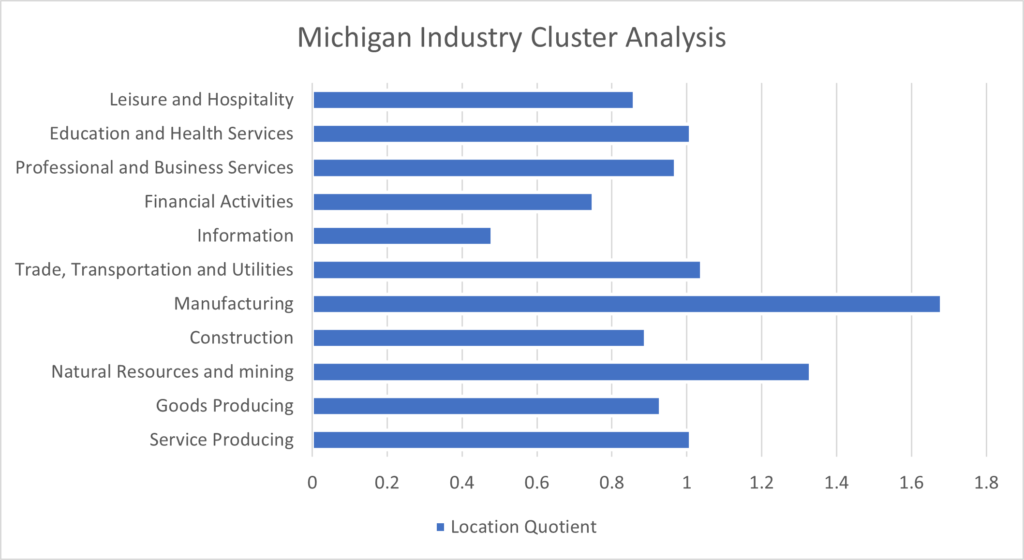Michigan is a global leader in manufacturing by any measure and in line with the traditional manufacturing strength of the Great Lakes region of the United States.
Industry clusters are regional concentrations of related industries.[i] Clusters consist of companies, suppliers, and service providers, as well as government agencies and other institutions that provide education, information, research, and technical support to a regional economy.[ii] Clusters are a network of economic relationships that create a competitive advantage for the related firms in a particular region, and this advantage then becomes an enticement for similar industries and suppliers to those industries to develop or relocate to a region.[iii] Clusters exist in all types of economies and are more prevalent in locations that achieve better performance relative to their overall stage of development.[iv] It is useful to view economies through the lens of clusters rather than specific types of companies, industries, or sectors because clusters capture the important linkages and potential spillovers of technology, skills, and information that cut across firms and industries.[v] Viewing a group of companies and institutions as a cluster highlights opportunities for coordination and mutual improvement.
A Location quotient is an indicator of the economic concentration of a certain industry in a state, region, county, or city compared to a base economy, such as a state or nation that measures industry clusters in a region. A location quotient greater than 1 indicates the concentration of that industry in the area. A location quotient greater than 1 typically indicates an industry that is export oriented. An industry with a location quotient of 1 with a high number of jobs present is likely a big exporter and is bringing economic value to the community feeding the retail trade and food services sectors.

Source: US Bureau of Labor Statistics
As the Michigan industry cluster analysis above indicates, Michigan is far above the national average in wages created in the manufacturing industry. As the table below illustrates, the top occupations in Michigan are heavily tied to the manufacturing industry.

Source: US Bureau of Labor Statistics
Michigan also has a broad spectrum of products that it manufactures as illustrated by the chart below. It is no surprise that the home of the global auto industry has nearly four times the national average of workers in the transportation equipment manufacturing center.

Looking into some of Michigan’s regions for their industry strength, it is interesting to note that even Grand Rapids, which is seen as also an advanced services jobs center, has its main industry strength in manufacturing as illustrated by the chart below.

Source: US Bureau of Labor Statistics
Regions such as Lansing, the home of Michigan’s state government, have a higher industry concentration in public administration but manufacturing remains above national averages even in central Michigan. Michigan also compares well with other states when comparing its manufacturing prowess as the table below illustrates. Manufacturing also remains above national averages in the hospitality center of Grand Traverse County.

Source: US Bureau of Labor Statistics
Michigan’s success in manufacturing is even more impressive considering the state’s relatively high production worker wage rate as compared to southern state competitors. It is interesting to note that Michigan’s annual mean wage rate for production workers is slightly lower than their neighbors in Indiana who are known for their low cost of doing business.

Michigan remains a manufacturing powerhouse throughout the state.
[i] https://www.ibrc.indiana.edu/ibr/2015/spring/article2.html
[ii] Ibid.
[iii] Ibid.
[iv] https://clustermapping.us/content/clusters-101
[v] Ibid.